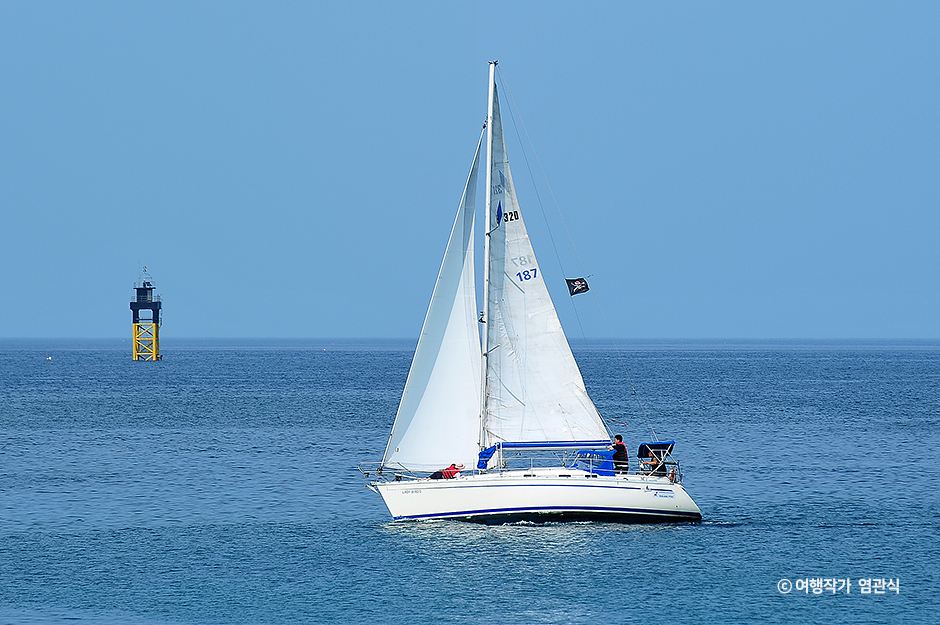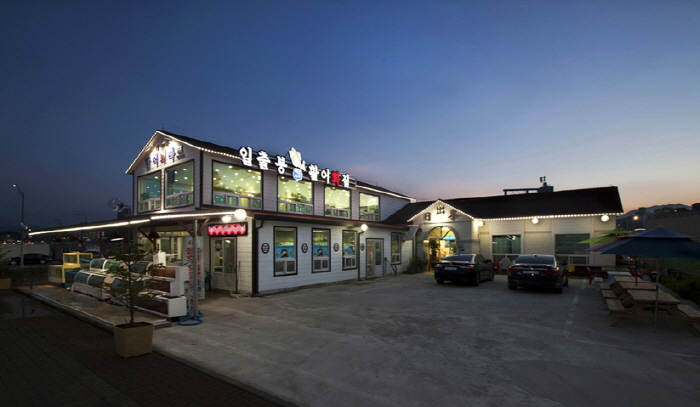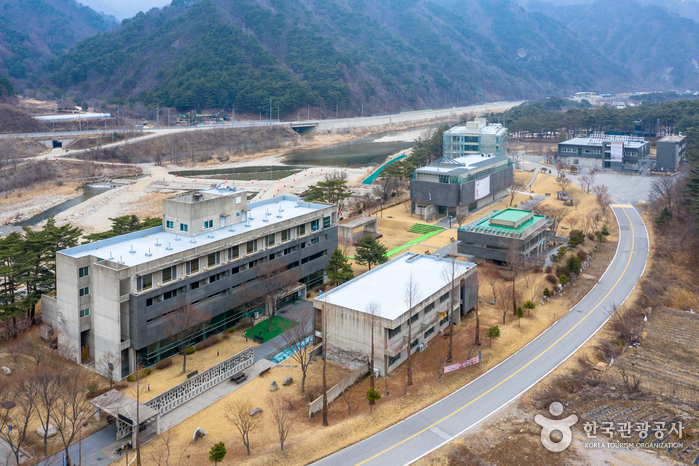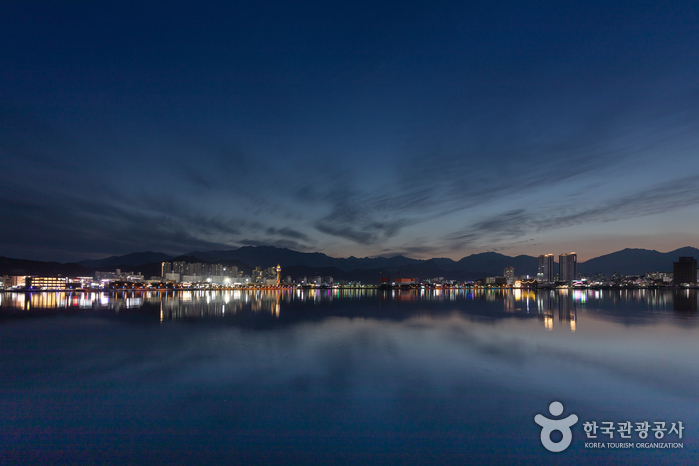Sokcho Marina (속초마리나)
16.7Km 2024-04-08
106 Cheolsae-gil, Sokcho-si, Gangwon-do
Sokcho Marina is a great place to visit with family members in the maritime city of Sokcho. Looking at the East Sea is lovely, but sailing through the blue sea is even more enjoyable. Sokcho Marina has a 12-seater cruise yacht suited for family and friends as well as a sailing yacht where passengers can soak up the romantic mood. By the dock is Cafe Marina where one can enjoy the view of yachts anchored in the bay through the window. The cruise route starts from Cheongchoho Lake and passes by Seorakdaegyo Bridge and Sokcho Beach, and turns around Jodo Island, one of the eight scenic sights of Sokcho, before returning to the dock.
Ilchulbong Hoetjip (일출봉횟집)
16.7Km 2024-02-28
77 Haeoreum-ro, Sokcho-si, Gangwon-do
+82-33-635-2222
Ilchulbong Hoetjip is known for offering a plentiful fresh raw fish. The menu features a variety of dishes made with fresh, wild-caught fish purchased at an early morning auction. Their hoe (sliced raw fish) is served with side dishes of seasonal seafood and delicious maeuntang (spicy fish stew). The restaurant is located on the waterfront, enabling visitors to dine while enjoying the view of the East Sea. It also features a rooftop on the 5th floor.
Chungchosoo Mul Hoe (청초수물회)
16.7Km 2024-02-16
12-36 Expo-ro, Sokcho-si, Gangwon-do
033-635-5050
Situated by Cheongchoho Lake in Sokcho, Chungchosoo Mul Hoe is renowned for its Haejeon mul hoe (cold raw fish soup with sea cucumber and abalone). The unique soup base is crafted by blending beef bone broth with traditional sauces, which is then aged for flavor enhancement. This rich soup is combined with an assortment of ingredients such as sliced raw fish, abalone, sea cucumber, sea squirt, octopus, and flying fish roe. Other popular menu items include seop guk, a mussle-based soup; seonggeal bibimbap, a sea urchin roe bibimbap; and ojingeo sundae, a specialty dish where a squid is stuffed with beef and vegetables.
Manhae Village (만해마을)
17.0Km 2021-07-29
91, Manhae-ro, Inje-gun, Gangwon-do
+82-33-462-2303
Manhae Village was established as a training center and memorial hall for national activist Monk Manhae Han Yongun, revered for his literary and philosophical inspiration, as well as his devotion to the nation and Korean people during the Democracy Movement.
Cheongchoho Lake (청초호)
17.0Km 2021-08-18
Cheongchohoban-ro, Sokcho-si, Gangwon-do
+82-33-639-2690
Cheongchoho Lake, located in the center of Sokcho city, is a large natural lake with a circumference of 5 m and an area of 1.3 km2. The source water originates from the Misiryeong Valley of Taebaek Mountain Range and flows to the Cheongchocheon Stream and to this beautiful lake, and then continues to the adjacent sea. So, the lake is an intermediate stop between the river and the sea. Cheongchojeong Pavilion is located above the lake, offering an open view of Seoraksan Mountain and the East Sea. As it is situated at the end of the 75 m-long ocean bridge, you will feel standing in the middle of the lake and enjoy a panoramic view of the lake. Shining more at night, this pavilion is regarded as the best attraction for the beautiful night view in Sokcho. It also attracts visitors’ attraction with its sculptures of the blue and yellow dragons, which were established based on the local legend associated with Cheongchoho Lake. The trail built around the lakeside is equipped with a nighttime lighting system so that many people visit it at night and the benches for rest and appreciating the view. There are many attractions around the lake, such as Seokbong Ceramic Museum, bird sanctuary, etc. The Cheongchoho Lake Park was the venue of the International Travel Expo ’99 Kangwon and is known for its 73.4 m high Expo Tower Observatory.
Nepa - Sokcho Branch [Tax Refund Shop] (네파 속초직영)
17.0Km 2024-04-18
70, Jungang-ro, Sokcho-si, Gangwon-do
-
Oeongchihaebyeon Beach (외옹치해변)
17.1Km 2025-02-04
596-2 Daepo-dong, Sokcho-si, Gangwon-do
Oeongchihaebyeon Beach is a small white sand beach with a length of 400 meters and a x_width of 50 meters, located between Sokchohaebyeon Beach and Daepohang Port. If you want to enjoy the peaceful waters of Sokcho, this is the place to go. The beach is open for swimming in the summer, and you can easily buy and enjoy freshly prepared raw fish from the nearby Oeongchi Port. Facilities such as restrooms and parking area are available.
The North Face - Sokcho Branch [Tax Refund Shop] (노스페이스속초점)
17.1Km 2024-04-16
76, Jungang-ro, Sokcho-si, Gangwon-do
-






![The North Face - Sokcho Branch [Tax Refund Shop] (노스페이스속초점)](http://tong.visitkorea.or.kr/cms/resource/05/2882905_image2_1.jpg)
![Mountia [Tax Refund Shop] (마운티아)](http://tong.visitkorea.or.kr/cms/resource/08/2882908_image2_1.jpg)
![Pro [Tax Refund Shop] (프로스펙스)](http://tong.visitkorea.or.kr/cms/resource/02/2882902_image2_1.jpg)
 English
English
 한국어
한국어 日本語
日本語 中文(简体)
中文(简体) Deutsch
Deutsch Français
Français Español
Español Русский
Русский